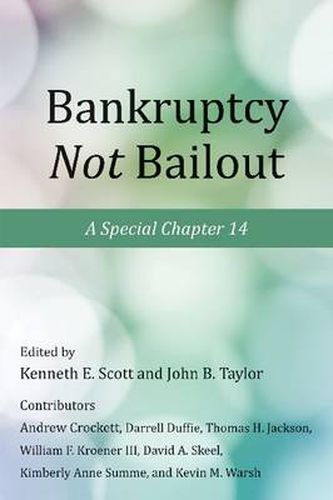Readings Newsletter
Become a Readings Member to make your shopping experience even easier.
Sign in or sign up for free!
You’re not far away from qualifying for FREE standard shipping within Australia
You’ve qualified for FREE standard shipping within Australia
The cart is loading…






The events of the last several years on Wall Street make a compelling case for comprehensive, fundamental reform in the oversight of financial firms. In Bankruptcy Not Bailout, a group of expert contributors show why, if a new addition to the bankruptcy laws-Chapter 14-were implemented along with other genuine reforms, the changes could strengthen the US financial system and provide the impetus the US economy needs to thrive once again.
The authors reveal the weaknesses in Dodd-Frank Title II, showing how the current law creates an elaborate, and potentially cumbersome, bureaucratic procedure for triggering seizure of a financial company-and tell why Chapter 14 could greatly improve that process, creating greater financial stability and reducing the likelihood of bailouts. They lay the groundwork for a return to a clearer, more rules-based oversight regime that relies more on real capital and true market forces and urge adoption of a Chapter 14 even were Dodd-Frank left untouched.
CONTRIBUTORS: Andrew Crockett, Darrell Duffie, Thomas H. Jackson, William F. Kroener III, Kenneth E. Scott, David A. Skeel, Kimberly Anne Summe, John B. Taylor, Kevin M. Warsh
$9.00 standard shipping within Australia
FREE standard shipping within Australia for orders over $100.00
Express & International shipping calculated at checkout
The events of the last several years on Wall Street make a compelling case for comprehensive, fundamental reform in the oversight of financial firms. In Bankruptcy Not Bailout, a group of expert contributors show why, if a new addition to the bankruptcy laws-Chapter 14-were implemented along with other genuine reforms, the changes could strengthen the US financial system and provide the impetus the US economy needs to thrive once again.
The authors reveal the weaknesses in Dodd-Frank Title II, showing how the current law creates an elaborate, and potentially cumbersome, bureaucratic procedure for triggering seizure of a financial company-and tell why Chapter 14 could greatly improve that process, creating greater financial stability and reducing the likelihood of bailouts. They lay the groundwork for a return to a clearer, more rules-based oversight regime that relies more on real capital and true market forces and urge adoption of a Chapter 14 even were Dodd-Frank left untouched.
CONTRIBUTORS: Andrew Crockett, Darrell Duffie, Thomas H. Jackson, William F. Kroener III, Kenneth E. Scott, David A. Skeel, Kimberly Anne Summe, John B. Taylor, Kevin M. Warsh